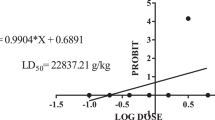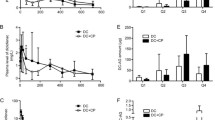Abstract
The gastrointestinal tolerability of metamizol and acetaminophen [weak cyclooxygenase (COX) inhibitors] in comparison with diclofenac (nonselective cyclooxygenase inhibitor) was evaluated in subchronic treatments in rats. Wistar rats recived 60 mg/kg body weight of metamizol and acetaminophen, and 3 mg/kg body weight of diclofenac by oral route twice daily for 14 days. Myeloperoxidase activity, an index of neutrophil infiltration, COX expression and the effects on blood parameters used as indicators of liver and renal functions were also studied. Metamizol and acetaminophen did not cause apparent gastrointestinal lesions; in contrast diclofenac showed swelling and an increased thickness on the distal intestinal mucosa. Myeloperoxidase activity was significantly increased in the small bowel with diclofenac treatment. In gastric mucosa the expression of the cyclooxygenase-1 was not affected and the expression of cyclooxygenase-2 was not observed. Diclofenac treatment significantly diminished hematocrit, hemoglobin, and corpuscular volume and increased the number of platelets. Aspartate aminotransferase and γ-glutamyltransferase activity were also altered and, regarding the renal biochemical parameters, the animals treated with diclofenac had increased urea values. In contrast, acetaminophen treatment did not affect either of these parameters and metamizol increased only the alanine aminotransferase activity. Under our experimental conditions, metamizol and acetaminophen seem to be safe drugs. In contrast, with diclofenac treatment blood loss and anemia are observed which could stem from the small intestinal injury. Moreover, this drug could to impair kidney function.
Similar content being viewed by others
REFERENCES
Langman MJ: Epidemiology of non-steroidal anti-inflammatory drug damage to stomach and duodenum. Ital J Gastroenterol Hepatol. 31(suppl 1):S2–S5, 1999
Hawkins C, Hanks GW: The gastroduodenal toxicity of nonsteroidal anti-inflammatory drugs: a review of the literature. J Pain Symptom Manage 20(2):140–151, 2000
Niemi T, Tanskanen P, Taxell C, Juvela S, Randell T, Rosenberg P: Effects of nonsteroidal anti-inflammatory drugs on hemostasis in patients with aneurysmal subarachnoid hemorrhage. J Neurosurg Anesthesiol 11(3):188–194, 1999
Whelton A: Nephrotoxicity of nonsteroidal anti-inflammatory drugs: physiologic foundations and clinical implications. Am J Med 106(5B):13S–24S, 1999
Feria M: Fármacos analgésicos-antitérmicos y antiinflamatorios no esteroideos. Antiartriticos. In Farmacologia Humana. J Flórez, JA Armijo, A Mediavilla (eds). Barcelona, Masson SA, 1997, pp 355–387
Crofford MJ: COX-1 and COX-2 tissue expression: implications and predictions. J Rheumatol. 24(suppl 49):15–19, 1997
Bosch-Marcé M, Titos E, Clària J: Nuevos conocimientos en la inhibicio´n de la ciclooxigenasa. Gastroenterol Hepatol 21(3):9–18, 1998
Vane JR, Botting RM: Mechanism of action of nonsteroidal anttinflammatory drugs. Am J Med 104(3A):2S-8S, 1998
Simon LS: Role and regulation of cyclo-oxygenase-2 during inflammation. Am J Med 106(5B):37S-42S, 1999
Morise Z, Grisham MB: Molecular mechanism involved in NSAID-induced gastropathy. J Clin Gastroenterol 27(1):S87–S90, 1998
Wallace, J.L.: Nonsteroidal anti-inflammatory drugs and gastroenteropathy: the second hundred years. Gastroenterology 112:1000–1016, 1997
Bianchi Porro G, Ardizzone S, Petrillo M, Caruso I, Montrone F: Endoscopic assessment of the effects of dipyrone (metamizol) in comparison to paracetamol and placebo on the gastroc and duodenal mucosa of healthy adult volunteers. Digestion 57:186–190, 1996
Nakamoto K, Kamisaki Y, Wada K, Kawasaki H, Itoh T: Protective effect of acetaminophen against acute gastric mucosal lesions induced by ischemia-reperfusion in the rat. Pharmacology 54:203–210, 1997
Brogden RN: Pyrazolone derivatives. Drugs 32:60–70, 1986
Clissold SP: Paracetamol and phenacetin. Drugs 32(suppl 4):46–59, 1986
Campos C, de Gregorio R, Garcia Nieto R, Gago F, Ortiz P, Alemany S: Regulation of cyclooxygenase activity by metamizol. Eur J Pharmacol 378:339–347, 1999
Shield MJ: Diclofenac/Misoprostol: novel findings and their clinical potential. J Rheumatol 25(suppl 51):31–41, 1998
Reuter BK, Davies NM, Wallace JL: Nonsteroidal anti-inflammatory drug enteropathy in rats: role of permeability, bacteria and enterohepatic circulation. Gastroenterology 112:109–117, 1997
Andrade SE, Martinez C, Walker AM: Comparative safety evaluation of non-narcotic analgesics. J Clin Epidemiol 51(12):1357–1365, 1998
Grisham MB, Beniot JN, Granger DN: Assessement of leucocyte in involvement during ischemia and reperfusion on the intestine. In Methods in Enzymology. Oxygen radicals in biological systems. L Packer, AE Glazer (eds). San Diego, Academic Press, 1990, pp 729–741
Villegas I, Martin MJ, LaCasa C, Motilva V, Alarcón de la Lastra C: Effects of meloxicam on oxygen radicasl generation in rat gastric mucosa. Inflamm Res 49:361–366, 2000
Sánchez S, Martin MJ, Ortiz P, Motilva V, Alarcón de la Lastra C: Effects of dipyrone on inflammatory infiltration and oxydative metabolism in gastric mucosa. Comparison with acetaminophen and diclofenac. Dig Dis Sci 47:1389–1398, 2002
Skeljo MV, Cook GA, Elliott SL, Giraud AS, Yeomans ND: Gastric mucosal adaptation to diclofenac injury. Dig Dis Sci 41(1):32–39, 1996
Olivero JJ, Graham DY: Gastric adaptation to nonsteroidal antiinflammatory drugs in man. Scand J Gastroenterol 27(suppl 193):53–58, 1992
Wallace JL, McKnight GW, Bell CJ: Adaptation of rat gastric mucosa to aspirin requires mucosal contact. Am J Physiol 268:G134–G138, 1995
Brzozowski T, Konturek PC, Konturek SJ, Ernst H, Stachura J, Hahn EG: Gastric adaptation to injury by repeated doses of aspirin strengthens mucosal defence against subsequent exposure to various strong irritants in rats. Gut 37:749–757, 1995
Davies NM, Jamali F, Skeith KJ: Nonsteroidal antiinflammatory drug-induced enteropathy and severe chronic anemia in a patient with rheumatoid arthritis. Arthritis Rheum 39:321–324, 1996
Colville-Nash PR, Gilroy DW: Potencial adverse effects of cycloocygenase-2 inhibition: evidence from animal models of inflammation. BioDrugs 15:1–9, 2001
Halter F, Tarnawski AS, Schmassmann A, Peskar BM: Cyclooxygenase 2-implications on maintenance of gastric mucosal integrity and ulcer healing: controversial issues and perspectives. Gut 49:443–453, 2001
Ávila JR, Alarcón de la Lastra C, Martin MJ, Motilva V, Luque I, Delgado D, J Esteban, J Herrerías: Role of endogenous sulphydryls and neutrophils infiltration in the pathogenesis of gastric mucosal injury induced by piroxicam in rats. Inflamm Res 45:83–88, 1996
Morise Z, Grisham MB: Molecular mechanism involved in NSAID-induced gastropathy. J Clin Gastroenterol 27:S87–S90, 1998
Rhodes JM, Tsai HH: Bioquimica hepática anormal. In Problemas Clinicos en Gastroenterologia. JM Rhodes, HH Tsai (eds). Madrid, Mosby, 1996, pp 235–238
Johnson PJ: The assessment of hepatic function and investigation of jaundice. In Clinical biochemistry. Metabolic and clinical aspects. WJ Marshall, SK Bangert (eds). New York, Churchill Livingstone, 1995, pp 217–236
Samarasinghe DA, George J, Farrell GC: Drug-induced liver disease. In Current Hepatology. G Gitnick (ed). St Louis, Mosby, 1994, pp 117–167
Farrell G: Drug-induced hepatic injury. J Gastroenterol Hepatol 12(suppl):S242–S250, 1997
Bjorkman D: Nonsteroidal anti-inflammatory drug associated toxicity of the liver, lower gastrointestinal tract, and esophagus. Am J Med 105(5A):17S-21S, 1998
Ward KM, Cockayne S: Enzimologia. In Química Clinica., SC Anderson, S Cockayne (eds). México, Interamericana McGraw-Hill, 1995, pp 241–282
Author information
Authors and Affiliations
Rights and permissions
About this article
Cite this article
Sánchez, S., De La Lastra, C.A., Ortiz, P. et al. Gastrointestinal Tolerability of Metamizol, Acetaminophen, and Diclofenac in Subchronic Treatment in Rats. Dig Dis Sci 47, 2791–2798 (2002). https://doi.org/10.1023/A:1021077810548
Issue Date:
DOI: https://doi.org/10.1023/A:1021077810548




